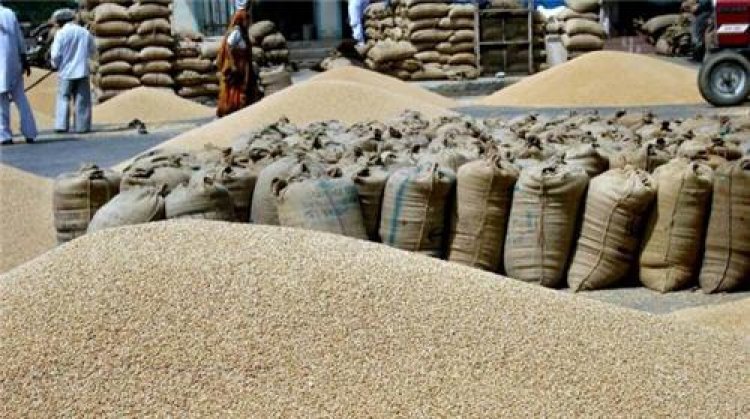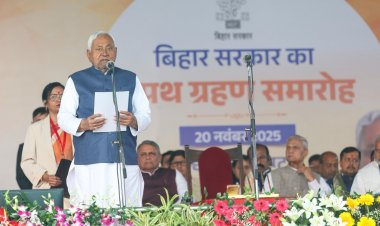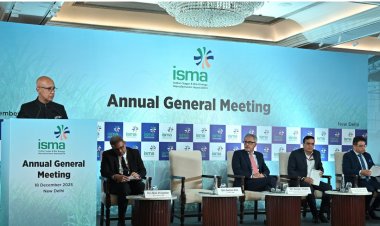Will wheat procurement end up at half the target?
Wheat prices are almost certain to shoot up this year after a long time due to a shortage of production and purchases made by the private sector for exports. The government may also lower the wheat production estimates because the amount of wheat arriving in the market is reducing. Exports, too, may remain much below the initial estimates.

Given the current scenario of wheat production and its public procurement, the Central Government estimates are likely to change on both counts. The way that the quantity of wheat arriving in the mandis and its public procurement are weakening clearly points to a decline in wheat production in the current Rabi season. Although the government has made no changes in the estimates of wheat production and public procurement as yet, it may accept this reality in the days to come and lower these estimates.
According to the figures from the Food Corporation of India (FCI) on 28 April 2022, 156.92 lakh tonnes (lt) of wheat has been procured by the government. The public procurement stands at 85.69 lt in Punjab, 36.96 lt in Haryana and 32.96 lt in Madhya Pradesh (MP). In Uttar Pradesh (UP), 1.23 lt of wheat has been procured while Rajasthan, Bihar and Uttarakhand have procured 1,000 tonnes each. Interestingly, the procurement in Chandigarh is equal to that in these three states together, i.e., 3,000 tonnes. There has been no public procurement in the rest of the states.
The government has estimated wheat production of 11.13 crore tonnes in the current Rabi season while a target of 444 lt has been fixed for public procurement. But the latter may end up at half the target if we go by the prevailing circumstances. Highly placed officials in the government are admitting that the production estimates, too, will have to be lowered. However, the Ministry of Agriculture has made no changes in the wheat production estimates as yet. Neither has the Food Ministry made any changes in the public procurement target of wheat.
According to the figures from the Punjab Mandi Board, the public procurement in Punjab has been 92.51 lt till April 30. For the first time after 2017, private companies and traders in the state have purchased 5.46 lt of wheat. Up to April 30 in the current season, the total quantity of wheat that has arrived is 98.13 lt, of which the government and the private sector together have purchased 97.97 lt. The total purchase of wheat in the mandis of Punjab had been 133.28 lt last year, which comprised 132.14 lt of public procurement and 1.14 lt of private-sector purchase.
Experts believe that the quantity of wheat arriving in the mandis of Punjab will only reduce in the days to come and the public procurement may barely touch the 100 lt mark. If we consider the public procurement in the states of Haryana and MP and the purchase in other states, including UP, indications are that the total public procurement may remain below 200 lt.
Given this scenario, wheat prices are almost certain to shoot up this year after a long time. The prices may go beyond Rs 2,500 per quintal because the private traders are incurring a cost higher than this. Obviously, they will sell the wheat only at a price above this, which will have a direct impact on the consumers in the form of an increase in flour prices.
The figures this year may rewrite the old records. It will perhaps be for the first time that the quantity of fresh procurement will be the same as the stocks in the central pool on April 1. The total availability with the government in the central pool may go down below 400 lt in the current season. According to FCI, the wheat stocks stood at 189.90 lt in the central pool on 1 April 2022. These had been 273.04 lt in April 2021 and 357.70 lt in 2020.
The government’s wheat production estimates for the current Rabi season remain unchanged at 11.13 crore tonnes even as farmers in most parts of the country say that their production has gone down by 15 to 25 per cent due to the unusual rise in temperature in March and April. Given this situation, the figures for the quantity of wheat arriving in the mandis of Punjab, the largest contributor to the wheat stocks in the central pool, seem to be proving true the apprehensions regarding the decline in production. In UP, too, farmers are talking about a decline in production. Rajbir Singh, a farmer from the Kansepur village of Saharanpur district, says that the production has gone down by up to 20 per cent this time.
The government requires about 260 lt of wheat per annum for distribution under the Targeted Public Distribution System (TPDS). Besides, 109.28 lt of wheat has been allocated for six months of the current year for free distribution of 5kg of foodgrains per person per month under the Pradhan Mantri Garib Kalyan Anna Yojana (PM-GKAY). Also, the buffer stock norms require 75 lt of wheat stocks in the central pool on April 1. Together, these amount to 445 lt. This seems to be a challenging figure for the government as it will have stocks of only about 400 lt. The continuation of the free foodgrains scheme for the entire year seems nearly impossible in such a situation. Besides, there will be limited capacity to curb prices through open market sales (OMS). The government sells 40-50 lt of wheat per annum to the flour mills in the off season under the OMS scheme.
For the first time after 2017, the private sector has purchased more than 5 lt of wheat in Punjab. The public procurement in MP, UP and Rajasthan have also remained less primarily due to the private sector purchasing wheat on a large scale at a price above the Minimum Support Price (MSP).
Wheat was purchased by the private sector in UP at up to Rs 2,100 per quintal, but the prices subsequently went up to Rs 2,200-Rs 2,300 per quintal. An official of a large global agri trading company said to Rural Voice, “We bought wheat initially at up to Rs 2,100 per quintal, but later the price crossed even Rs 2,300 per quintal.” The company has made these purchases in the districts of Chandausi, Bareilly, Shahjahanpur, Pilibhit and Badaun. It is estimated that the company will export 40 lt of wheat. Another Multinational Company (MNC) is slated to export about 100 lt of wheat, say agri trade experts. The company has booked rail rakes in large numbers from MP to Kandla. The Railways has also increased the rake fares recently, which perhaps is an indication that the government does not want to encourage wheat exports too much.



 Join the RuralVoice whatsapp group
Join the RuralVoice whatsapp group






































